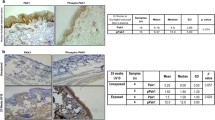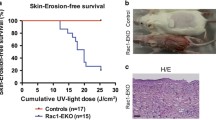Abstract
Skin cancer is the most common cancer in the United States. Ultraviolet B (UVB) radiation in sunlight is the major environmental factor causing skin cancer. p21, a p53-inducible protein, plays an important role in cell cycle, DNA repair, and apoptosis. Here we have investigated the effect of UVB radiation on p21 and its molecular mechanisms and function in human HaCaT keratinocytes, which we used as a premalignant cellular model because normal skin harbors numerous clones of p53-mutated keratinocytes. We found that in human HaCaT keratinocytes UVB induces rapid p21 down-regulation via a proteasomal degradation mechanism. In p53-defective HaCaT cells, the p21 protein levels remain decreased at a later time post-UVB, but in normal human and mouse epidermal keratinocytes with wild-type p53 the p21 levels are initially reduced but later increase post-UVB. These findings indicate that loss of p53 function leads to sustained p21 down-regulation in response to UVB damage. Degradation of p21 following UVB radiation does not require ATR, ATM, or both, because either the ATR/ATM inhibitor caffeine or siRNA knockdown of ATR, ATM, or both failed to reverse p21 degradation. However, inhibiting MDM2 or GSK3b partially reduced UVB-induced p21 degradation, while inhibiting both enzymes completely prevented it. Restoring the p21 protein levels in UVB-irradiated keratinocytes reduced apoptosis. Although at the molecular level increasing p21 expression has no effect on the protein levels of the Bcl-2 family members, it enhances the activation of AKT, a critical survival pathway to protect cells from apoptosis. Our results suggest a distinct mechanism of p21 degradation in keratinocytes by UVB, and this p21 degradation may significantly enhance UVB-induced apoptosis of premalignant keratinocytes with a p53 defect to eliminate damaged cells and therefore prevent skin cancer development.
Similar content being viewed by others
Abbreviations
- AKT:
-
Aserine-threonine kinase, downstream of PI3K, also called protein kinase B
- ATM:
-
Ataxia-telangiectasia mutated
- ATR:
-
Ataxia-telangiectasia and Rad3-related
- EGFR:
-
Epidermal growth factor receptor
- ERK:
-
Extracellular signal-regulated kinase
- GSK3b:
-
Glycogen Synthase Kinase 3beta
- MAPK:
-
Mitogen activated protein kinase
- MDM2:
-
Murine double minute
- NMSC:
-
Non-melanoma skin cancer
- PI3K:
-
Phosphatidylinosital-3 kinase
- siRNA:
-
Small interfering RNA
- UVA:
-
Ultraviolet A (315–400 nm)
- UVB:
-
Ultraviolet B (280–315 nm)
References
T. Abbas, A. Dutta Nat. Rev. Cancer, 2009, 9, 400–414.
A. L. Gartel, A. L. Tyner Mol. Cancer Therapeut., 2002, 1, 639–649.
M. Bendjennat, J. Boulaire, T. Jascur, H. Brickner, V. Barbier, A. Sarasin, A. Fotedar, R. Fotedar Cell, 2003, 114, 599–610.
H. Lee, S. X. Zeng, H. Lu J. Biol. Chem., 2006, 281, 26876–26883.
J. Y. Lee, S. J. Yu, Y. G. Park, J. Kim, J. Sohn Mol. Cell. Biol., 2007, 27, 3187–3198.
H. Nishitani, Y. Shiomi, H. Iida, M. Michishita, T. Takami, T. Tsurimoto J. Biol. Chem., 2008, 283, 29045–29052.
G. Soria, J. Speroni, O. L. Podhajcer, C. Prives, V. Gottifredi J. Cell Sci., 2008, 121, 3271–3282.
T. Stoyanova, T. Yoon, D. Kopanja, M. B. Mokyr, P. Raychaudhuri Mol. Cell. Biol., 2008, 28, 177–187.
F. Ponten, B. Berne, Z. P. Ren, M. Nister, J. Ponten J. Invest. Dermatol., 1995, 105, 402–406.
Z. Y. Abd Elmageed, R. L. Gaur, M. Williams, M. E. Abdraboh, P. N. Rao, M. H. Raj, F. M. Ismail, A. Ouhtit J. Invest. Dermatol., 2009, 129, 175–183.
J. P. Therrien, M. Loignon, R. Drouin, E. A. Drobetsky Cancer Res., 2001, 61, 3781–3786.
A. S. Jonason, S. Kunala, G. J. Price, R. J. Restifo, H. M. Spinelli, J. A. Persing, D. J. Leffell, R. E. Tarone, D. E. Brash Proc. Natl. Acad. Sci. U. S. A., 1996, 93, 14025–14029.
F. R. de Gruijl Exp. Dermatol., 2002, 11, 37–39.
F. R. de Gruijl, H. Rebel Photochem. Photobiol., 2008, 84, 382–387.
G. Ling, A. Persson, B. Berne, M. Uhlen, J. Lundeberg, F. Ponten Am. J. Pathol., 2001, 159, 1247–1253.
H. Nakazawa, D. English, P. L. Randell, K. Nakazawa, N. Martel, B. K. Armstrong, H. Yamasaki Proc. Natl. Acad. Sci. U. S. A., 1994, 91, 360–364.
Y. Y. He, J. L. Huang, M. L. Block, J. S. Hong, C. F. Chignell J. Invest. Dermatol., 2005, 125, 560–566.
M. Ming, W. Han, J. Maddox, K. Soltani, C. R. Shea, D. M. Freeman, Y. Y. He Oncogene, 2010, 29, 492–502.
Y. Y. He, J. Pi, J. L. Huang, B. A. Diwan, M. P. Waalkes, C. F. Chignell Oncogene, 2006, 25, 3680–3688.
Y. Y. He, S. E. Council, L. Feng, C. F. Chignell Cancer Res., 2008, 68, 3752–3758.
W. Han, Y. Y. He Photochem. Photobiol., 2009.
K. Yoon, R. C. Smart Mol. Cell. Biol., 2004, 24, 10650–10660.
K. A. Cimprich, D. Cortez Nat. Rev. Mol. Cell Biol., 2008, 9, 616–627.
B. B. Zhou, S. J. Elledge Nature, 2000, 408, 433–439.
Y. Jin, H. Lee, S. X. Zeng, M. S. Dai, H. Lu EMBO J., 2003, 22, 6365–6377.
Z. Zhang, H. Wang, M. Li, S. Agrawal, X. Chen, R. Zhang J. Biol. Chem., 2004, 279, 16000–16006.
D. A. Cross, D. R. Alessi, P. Cohen, M. Andjelkovich, B. A. Hemmings Nature, 1995, 378, 785–789.
J. A. Diehl, M. Cheng, M. F. Roussel, C. J. Sherr Genes Dev., 1998, 12, 3499–3511.
D. T. Chao, S. J. Korsmeyer Annu. Rev. Immunol., 1998, 16, 395–419.
R. J. Youle, A. Strasser Nat. Rev. Mol. Cell Biol., 2008, 9, 47–59.
S. Cory, J. M. Adams Nat. Rev. Cancer, 2002, 2, 647–656.
A. M. Bode, Z. Dong Science’s STKE, 2003, 2003, 2re.
G. T. Bowden Nat. Rev. Cancer, 2004, 4, 23–35.
Y. Y. He, J. L. Huang, C. F. Chignell J. Biol. Chem., 2004, 279, 53867–53874.
T. Stoyanova, N. Roy, D. Kopanja, S. Bagchi, P. Raychaudhuri Proc. Natl. Acad. Sci. U. S. A., 2009, 106, 10690–10695.
X. Lu, D. P. Lane Cell, 1993, 75, 765–778.
D. E. Brash, J. A. Rudolph, J. A. Simon, A. Lin, G. J. McKenna, H. P. Baden, A. J. Halperin, J. Ponten Proc. Natl. Acad. Sci. U. S. A., 1991, 88, 10124–10128.
W. S. el-Deiry, T. Tokino, V. E. Velculescu, D. B. Levy, R. Parsons, J. M. Trent, D. Lin, W. E. Mercer, K. W. Kinzler, B. Vogelstein Cell, 1993, 75, 817–825.
C. Deng, P. Zhang, J. W. Harper, S. J. Elledge, P. Leder Cell, 1995, 82, 675–684.
J. Brugarolas, C. Chandrasekaran, J. I. Gordon, D. Beach, T. Jacks, G. J. Hannon Nature, 1995, 377, 552–557.
T. A. Lehman, R. Modali, P. Boukamp, J. Stanek, W. P. Bennett, J. A. Welsh, R. A. Metcalf, M. R. Stampfer, N. Fusenig, E. M. Rogan et al. Carcinogenesis, 1993, 14, 833–839.
U. Henseleit, J. Zhang, R. Wanner, I. Haase, G. Kolde, T. Rosenbach J. Invest. Dermatol., 1997, 109, 722–727.
J. M. Paramio, C. Segrelles, S. Lain, E. Gomez-Casero, D. P. Lane, E. B. Lane, J. L. Jorcano Mol. Carcinog., 2000, 29, 251–262.
N. H. Chehab, A. Malikzay, M. Appel, T. D. Halazonetis Genes Dev., 2000, 14, 278–288.
S. Y. Shieh, J. Ahn, K. Tamai, Y. Taya, C. Prives Genes Dev., 2000, 14, 289–300.
Y. H. Ou, P. H. Chung, T. P. Sun, S. Y. Shieh Mol. Biol. Cell, 2005, 16, 1684–1695.
T. Abbas, U. Sivaprasad, K. Terai, V. Amador, M. Pagano, A. Dutta Genes Dev., 2008, 22, 2496–2506.
K. Sugasawa DNA Repair, 2009, 8, 969–972.
D. Banks, M. Wu, L. A. Higa, N. Gavrilova, J. Quan, T. Ye, R. Kobayashi, H. Sun, H. Zhang Cell Cycle, 2006, 5, 1719–1729.
F. Marini, T. Nardo, M. Giannattasio, M. Minuzzo, M. Stefanini, P. Plevani, M. Muzi Falconi Proc. Natl. Acad. Sci. U. S. A., 2006, 103, 17325–17330.
G. Soria, O. Podhajcer, C. Prives, V. Gottifredi Oncogene, 2006, 25, 2829–2838.
J. Saegusa, D. K. Hsu, W. Liu, I. Kuwabara, Y. Kuwabara, L. Yu, F. T. Liu J. Invest. Dermatol., 2008, 128, 2403–2411.
D. Decraene, A. Van Laethem, P. Agostinis, L. De Peuter, H. Degreef, R. Bouillon, M. Garmyn J. Invest. Dermatol., 2004, 123, 207–212.
Author information
Authors and Affiliations
Corresponding author
Rights and permissions
About this article
Cite this article
Lei, X., Liu, B., Han, W. et al. UVB-Induced p21 degradation promotes apoptosis of human keratinocytes. Photochem Photobiol Sci 9, 1640–1648 (2010). https://doi.org/10.1039/c0pp00244e
Received:
Accepted:
Published:
Issue Date:
DOI: https://doi.org/10.1039/c0pp00244e




